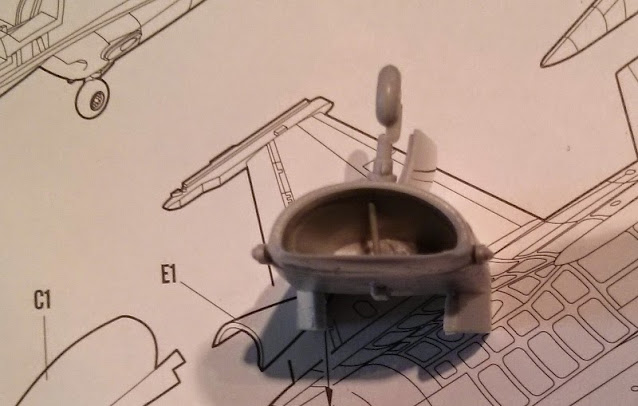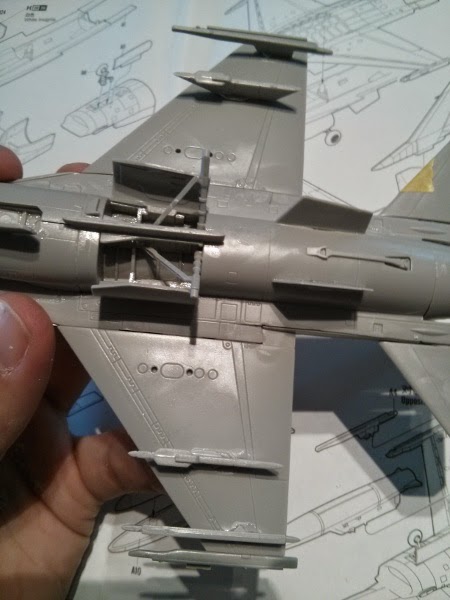While I was looking for my bottle of primer I stumbled upon my small Grey Primer bottle, that I decided to use out of the way so that it wouldn't stupidly end up drying inside its container. First I primed the cockpit and proceeded to cover the top side of the plane. The last drops I sprayed over the bottom part, but it wasn't nearly enough. So I switched to the Grey Surface Primer for the rest of the plane. I don't know what for, but the darker grey was much nicer to airbrush on, sadly those small bottles are pretty inconvenient for primer.
Next I can attack the cockpit details, maybe I even get to finish it with a very reasonable timeframe. Then I can mask the canopy, paint the insides of the it and glue both pieces on the plane, for the real painting. Then I have to come up with a pattern. Something that's not grey, preferrably, but I fear that the air forces keep disagreeing with me on these stylish details.
Random, weird and apparently verbose text about plastic models, 'mechs and gaming.
24.6.15
17.6.15
A single session build
The cockpit
I started my build with the normal "first the cockpit, then the rest over a couple of sessions" attitude. Because the cockpit was so very simply (the tub got the ejection seat, the IP and a joystick), I kept on building until I'd got to the point where I would have to paint something before assembling anything else anymore.The bottom half
After the cockpit I built the air scoop for the engine / front landing gear with its door. With the same flick of my wrist I glued that subassembly on the bottom part of the airframe. The wonderstick that was to be inserted into the air scoop tried to fight me a bit, but I won in the end.As I had got up to good speed with the bottom parts, I started working on the main landing gear. It got a pylon in the middle and a couple of small wings behind it on both sides. I had never noticed anything like these in Falcons before, but then again, I have never paid much attention to their shapes. To be honest, I barely regocnize the basic shape of the plane.
The installation of the main landing gear doors I pondered on for fifteen seconds. First I thought that gluing them on would make painting a bit more complicated, but as the bottom paintjob would most likely be a boring light monocolour, it wouldn't matter much. The only complication could be coming up with the most optimal painting order and the masking that requires.
Now I had arrived to the moment in my build that triggered a breakpoint. I pondered on that for a moment, dry-fitting pieces together, wondering if and how I could do the cockpit painting and decaling with a closed airframe. Finally I decided to ignore my concern of these tight spaces and kept on building.
 |
| Looking straight |
The rest of the build
 |
| The left rear wing tried to droop |
10.6.15
Project IV/15
A jadeless falcon
To return back to this planet, I popped a F-16A Falcon from my work queue. There was a silly propaganda plane on the box artwork, and I sure as hell wasn't going to mix my hands in those.
First things first, I checked the instructions so I'd know what sort of a project to except. This is not what I thought I'd see: the kit had even less pieces than in the astonishingly simple N/AW 'hog! Based on the last step this plane at least came with pylons, so I might not have to resort to any DIY hacks when I consider arming this plane.
Your eyes are not deceiving you, the kit consists of two sprues, a two-piece canopy and the top half of the airframe. For some reason (I still am not an expert in these modern-ish flying things) there was not a single seam moulded on either piece - or I was just staring at them too cross-eyedly. I guess I'll get some sort of clarity on that later on.
I didn't bother looking at the decals yet, as I was still so annoyed by the decals on the 'hog project.
3.6.15
Finished: Project III/15
Starting with the cockpit
I started building the walker just the way the instructions told me to: from the head. First I bent the general shape in and then attached the thing I'm going to call the window frame into the faceplate. After that (pic #3) I attached the chin guns and the wedge-shaped piece on top of the head.Connecting the head to the torse was done with a neck tube. You can't see it in the photos, but after bending and rebending the head's parts this way and that way the rearmost one broke off (as I hadn't yet figured out how to build this sort of a thing the most efficient way) and I superglued it into place later on. So I learned that I shouldn't bend anything before I absolutely had to, as these thin and often perforated finely cut pieces have to be manipulated a lot. That's bad business, as anyone I assume to know.
Now that all the more visible was done, I attached the chin guns on to the head's baseplate and then the baseplate in to the head. Of course the instructions had markings whether to just bend the attachment lips or to twist them around, depending on the place and part. I decided to follow my own lead, depending on how much sense the instructions made.
To satisfy my own curiosity I took a shortcut and bent the torso part in form and attached the neck on that one. That also helped me to support the broken neck while the superglue cured and the head was set into a good position.
Some leg work
The legs consisted of surprisingly many parts. First there was the "inner thigh" part, where I was to attach a thin strip bent into a double-rolled fishing hook -shaped slip to bring the thickness of the hip joint. On top of that (towards the center of gravity) the opposing plate of the topmost leg/hip part. Then this setup was completed with the outer side of the leg and the thickness was provided by bending the numerous flaps from both leg parts. Sounds much more complicated than what it was.As expected, the first leg was a prototype and after that it was just doing the same thing three more times. All this had taken about an hour, I think, in one sitting. I had prepared mentally to swear like a drunk pirate, but so far it had been smooth sailing. That was worrysome.
Engines
For some reason the engine tubes (Wookieepedia says they're "KDY FW62 compact fusion drive system") got their turn now that I already had the right-side legs connected into the belly plate. I think they'd been much easier to install first, but I guess someone else had a better idea.Funnily all the other pieces were to be bent or rolled following the tiny shapes, except these jokers. They were rolled against the texture. I just used the handle of my x-acto knife to start the bend and then did the rest manually. Of course I never got the round parts bent round enough, but they were close enough, as the connector lips helped with the positioning..
The back hump
A couple of tiny pieces were to be inserted into the rear armour plate of the AT-AT, so I did that before diving to the nervousness-causing foot pads. Not that it made much of a difference, as both pieces were just bent a and plugged in.Some paws
The left legs were done with the same routien. If my memory serves, I spent about 20 minutes with them, the back and the motors. Still, I had to leave the paws for my third and final session.I didn't think of taking a photo of it, but I'll confess that I built the first foot like an idiot. Firstly I started from the toes when I should've started with the ankle tube. Secondly I went and attached the ankle tube 90 degrees wrong, so I couldn't insert the walker's leg. So I had to untwist the connectors somehow, get the tube out, rotate it and reinsert it and retwist the connectors without ruining anything. Luckily I managed with that with good results.
Once again: when I had practiced with one, the rest went with ease. My All-Terrain Assault Transport was standing proudly on its feet, just like the Kuat Engineers had designed. What remained was inserting the belly plate into the torso. And yet again: I should've followed the instructions and gotten away a bit more easily than now. I guess I'll never learn, no matter how much I mumble about this same topic :)
A completed warmachine
I took a couple of posing pics when I was done. A couple of them were moved and the rest are what they are.This one got done so quickly, that I didn't see a point in dividing the construction and wrap-up phases into separate posts. And brings a bit of a change in this silly blog of mine!
Subscribe to:
Posts (Atom)














































